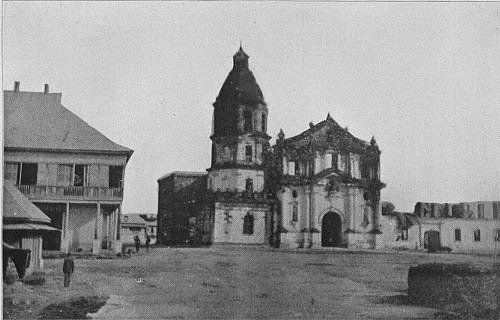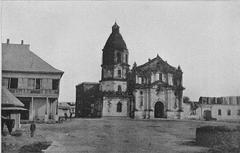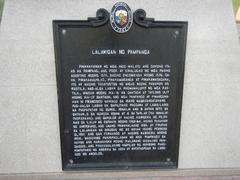
Visiting San Fernando Cathedral in Bacolor: History, Tips, and Visitor Information
Date: 31/07/2024
Introduction to San Fernando Cathedral
San Fernando Cathedral, also known as the Cathedral of Our Lady of the Assumption, is an iconic landmark nestled in the historic town of Bacolor, Pampanga, Philippines. This cathedral is a testament to religious devotion, resilience, and architectural grandeur. Originally constructed in 1755 by the Augustinian friars, the cathedral has undergone several phases of reconstruction and renovation, reflecting the dynamic history and cultural evolution of the region (Wikipedia). Over the centuries, it has witnessed significant historical events, including the Philippine Revolution and subsequent conflicts that shaped the nation (Benjie Layug). Today, the San Fernando Cathedral stands as a beacon of faith and history, attracting visitors from around the world who come to marvel at its Neo-Classical architecture and partake in its rich cultural and religious traditions. This comprehensive guide aims to provide you with all the necessary information to make your visit to San Fernando Cathedral a memorable experience.
Table of Contents
- Introduction
- History of San Fernando Cathedral
- Reconstruction and Modern Era
- Visitor Information
- Special Events and Guided Tours
- Cultural and Religious Impact
- Architectural Features and Interior
- Modern-Day Relevance
- FAQ
- Conclusion
History of San Fernando Cathedral
Early Beginnings and Construction
The San Fernando Cathedral has a rich history dating back to the mid-18th century. The initial structure on this site was built in 1755 by the Augustinian friars under the patronage of San Fernando III, King of Castile. This initial church was constructed using wood and thatch, reflecting the modest resources available at the time (Wikipedia).
In 1788, the church was transferred to the care of secular priests, marking a significant shift in its administration. The construction of the present-style church began under the supervision of Fr. Manuel Canlas, the first secular cura parroco, and a committee of the principales of the town (Benjie Layug).
Architectural Evolution
The church underwent several phases of construction and renovation. The present structure was likely completed by the end of the 18th century, with significant contributions from Fr. Sebastian Moreno and Fr. Mariano Alafont, who finished the construction in 1781. The church was restored in 1853 by Fr. Pedro Medina and again in 1866 by Fr. Antonio Redondo, who added the majestic dome and completed the interior painting (Benjie Layug).
The Neo-Classical facade of the cathedral features a large balustered portico, a profusion of columns, and a triangular pediment. The sides are adorned with dentils and tooth-like decorations. A round, majestic Baroque-style dome rises from the rotunda of the transept, adding to the architectural grandeur of the cathedral. The four-story hexagonal bell tower, which tapers up in uneven levels with alternating arched and segmented blind and open recesses, is another notable feature (Benjie Layug).
Historical Significance
The San Fernando Cathedral has played a pivotal role in the history of the Philippines. On October 9, 1898, President Emilio F. Aguinaldo and his cabinet viewed the Philippine Revolutionary Army from the windows of the convento, underscoring the cathedral’s importance as a strategic location during the Philippine Revolution (Wikipedia).
However, the cathedral also faced significant challenges. On May 4, 1899, under the orders of General Antonio Luna, the Philippine Revolutionary Army burned the church and convento as part of a scorched-earth policy to prevent the advancing American forces from using them. The church was destroyed by fire again in 1939, necessitating another round of reconstruction (Bluedreamer27).
Reconstruction and Modern Era
The cathedral was rebuilt in 1950 by Pampango architect Fernando H. Ocampo, known for his work on the Manila Cathedral. This reconstruction marked a significant transformation in the architectural style of the cathedral, shifting from its previous Baroque style to a new Neo-Classical style (Wikipedia).
In 1948, the church was elevated to the status of a cathedral when it became the seat of the Diocese of San Fernando, canonically created by Pope Pius XII. This elevation was a testament to the growing importance of the church within the Catholic hierarchy in the Philippines. In 1975, the diocese was further elevated to an archdiocese by Pope Paul VI, and the cathedral was rededicated as the Metropolitan Cathedral of San Fernando on December 11, 1998, during the Golden Jubilee anniversary of its creation as a diocese (Bluedreamer27).
Visitor Information
Visiting Hours and Tickets
San Fernando Cathedral is open to visitors daily from 6:00 AM to 6:00 PM. Entry is free, but donations are welcome to help maintain the cathedral.
Travel Tips
- Getting There: The cathedral is located 68.9 kilometers from Manila, approximately a 1.5-hour drive. Public transportation options include buses and jeepneys that travel to Bacolor.
- Nearby Attractions: While in Bacolor, you can also visit other historical sites such as the Bacolor Church and the San Guillermo Parish Church, which is partly buried by lahar from the Mount Pinatubo eruption.
- Accessibility: The cathedral is wheelchair accessible, ensuring that all visitors can enjoy its beauty and history.
Special Events and Guided Tours
The cathedral hosts various religious and cultural events throughout the year, including the annual feast of San Fernando on May 30. Guided tours are available upon request, providing deeper insights into its historical and architectural significance.
Cultural and Religious Impact
The San Fernando Cathedral is not only a religious landmark but also a cultural treasure. It was recently declared an important Cultural Property by the National Museum of the Philippines, highlighting its historical and cultural significance. The cathedral’s role in the community extends beyond its religious functions; it is a symbol of resilience and continuity for the people of San Fernando and the broader Pampanga region (Bluedreamer27).
Architectural Features and Interior
The cathedral measures 70 meters long, 13 meters wide, and 11 meters high, with a Tuscan interior that adds to its serene and majestic ambiance. The main altar is a focal point of the interior, designed to draw the eyes of the faithful towards the sacred space. The facade of the cathedral is simple yet elegant, coated in clean white and adorned with gray faux columns and balusters. The main entrance features a porch with the image of the Immaculate Heart of Mary above it, along with the Archdiocese coat of arms. Colorful stained-glass windows and a rose window featuring the image of Our Lady near its pediment add to the aesthetic appeal of the facade (Bluedreamer27).
Modern-Day Relevance
Today, the San Fernando Cathedral continues to be a vital part of the community. It serves as a place of worship, a historical landmark, and a cultural hub. The cathedral’s rich history and architectural beauty make it a must-visit destination for tourists and pilgrims alike. Its resilience in the face of numerous challenges over the centuries is a testament to the enduring faith and spirit of the people of San Fernando (Traveler on Foot).
FAQ
Q: What are the visiting hours for San Fernando Cathedral? A: The cathedral is open daily from 6:00 AM to 6:00 PM.
Q: Is there an entrance fee to visit the cathedral? A: No, entry is free, but donations are welcome.
Q: How can I get to San Fernando Cathedral from Manila? A: The cathedral is approximately a 1.5-hour drive from Manila. Public transportation options include buses and jeepneys that travel to Bacolor.
Q: Are guided tours available? A: Yes, guided tours are available upon request.
Conclusion
In summary, the San Fernando Cathedral stands as a monument to the rich history, architectural beauty, and enduring faith of the people of San Fernando, Pampanga. Its journey from a modest wooden structure to a grand Neo-Classical cathedral reflects the resilience and dedication of the community it serves. Plan your visit today to experience this cultural and historical gem firsthand.
References
- Wikipedia (n.d.). San Fernando Cathedral (Pampanga). Retrieved from https://en.wikipedia.org/wiki/San_Fernando_Cathedral_(Pampanga)
- Layug, B. (2011). Metropolitan Cathedral of San Fernando. Retrieved from http://benjielayug.com/2011/01/metropolitan-cathedral-of-san-fernando-san-fernando-city-pampanga.html
- Bluedreamer27. (n.d.). Metropolitan Cathedral of San Fernando, Pampanga. Retrieved from https://bluedreamer27.com/metropolitan-cathedral-of-san-fernando-pampanga/
- Traveler on Foot (2009). San Fernando Heritage District. Retrieved from https://traveleronfoot.wordpress.com/2009/09/03/san-fernando-heritage-district/



